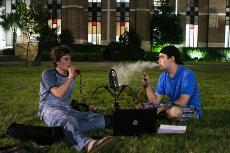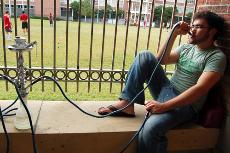Hookah smoking, one of the latest trends to hit Loyola, is sweeping across campuses and lounges nation-wide and increasing in popularity and usage.
Halfway across the world and nearly 1,000 years later, the Middle Eastern hookah smoking tradition has puffed up on Loyola’s campus proving to be an increasingly smokin’ trend.
Having many street names including hubbly-bubbly, water pipe, narghile, shisha and, of course, hookah. The word “hookah” actually refers to the smoking vessel, and “shisha” is the name of the sweet and flavorful tobacco that is smoked through the water pipe of a hookah.
Usually complimenting the personality of the owner, hookahs come in an array of colors, designs and sizes ranging from small and simple to colorful and elaborate glass hookahs. A hookah has a base, a stem and tubes attached to multiple protruding pipes that allow several users to smoke at once. Filtered through water at the base of the hookah, flavored tobacco is burned from charcoal and smoked through the pipes, usually lasting from 30 minutes to an hour.
If you haven’t been directly involved in the hookah movement, it’s likely you’ve witnessed a hookah rendezvous in passing. Usually taking place in grassy areas surrounding the J. Edgar and Louise S. Monroe Library or the sidewalks around the dorms at night, you’ve probably shimmied your way through a group of smokers and questioned the legality of the bong-like structure of the hookah, but nonetheless found the exotic, musty smells and bubbly sound effects intriguing.
Christian Bushardt, management freshman and avid hookah smoker, shot down stereotypical rumors. “Contrary to popular belief, hookahs are actually not intended for the consumption of illegal substances,” he said. “Marijuana usage will actually cause the hookah to clog up and be unusable … not that I know from personal experience.”
Although hookah can be smoked alone, it is more of a social event on and around campus, which Bushardt and his friends smoking hookah in the quad made apparent.
Juan Del Rosario, political science freshman, said, “After class it’s good to chill with the hookah…so you can get relaxed. That’s why I do it.”
Some students smoke hookah to relax after a long day, while others use it as a concentration mechanism. Loyola also provides a safe haven for students from other universities in which hookah smoking is banned.
John Crenshaw and Miles Potter are two examples. The laid-back hookah smoking duo frequents Loyola’s campus to smoke while studying economics. Potter jokingly explained their forced study pilgrimage from Tulane to Loyola in economic terms of “marginal benefits and opportunity costs.” Crenshaw and Potter exemplified the current hookah trend by attesting to usually smoking twice a day.
“I really like it. I’ll probably keep doing it,” Crenshaw said. “You’re probably going to see me around here a lot. You’ll probably see me on Loyola’s campus more than Tulane’s.”
Hookah smoking is certainly not limited to Loyola’s campus. In fact hookah is becoming popular on many campuses nationwide and has recently been commercialized on the nightlife scene in the form of hookah cafés. The Hookah Café New Orleans, located at 500 Frenchmen St. provides a chic lounge with Indian-inspired décor, tribal belly dancers, sultry live music and, of course, hookahs, which are available in a wide variety of fruity and minty flavors prepared according to personal preferences.
Whether smoking for relaxation, concentration or sheer entertainment, the reasons for hookah usage varies among smokers. However, the general consensus among hookah smokers seems to be the same – hookah really is all it’s puffed up to be.
Rita West can be reached at rmwest@loyno.edu.

Tulane freshmen John Crenshaw (left) smoke hookah in the Peace Quad Oct. 1. The two smoke at Loyola because of a hookah-prohibition at Tulane.






